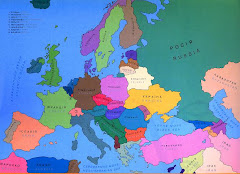 g interior of Cathedral in Yevpatoria.
g interior of Cathedral in Yevpatoria. Here's a subject from which I've shied away, mostly because I can't figure it out. What religious faiths do Ukrainians follow? I saw a poll last summer that showed the following percentages: Orthodox 77.3; Greek Catholic, 16.5; Protestant, 2.4; Muslim, 0.7; Roman Catholic, 0.5; other 2.8.
But under "Orthodox" there is a split too: Ukrainian Orthodox of the Moscow Patriachy, 41.7% (the current president is a member); Ukrainian Orthodox
 Church/Kyiv Patriachy,22%; Ukrainian Autocephalous/ Orthodox church, 2.3%; and other, about 23%.
Church/Kyiv Patriachy,22%; Ukrainian Autocephalous/ Orthodox church, 2.3%; and other, about 23%.I looked at the poll and put it aside. It re-appeared during one of my periodic house cleanings (well, room cleanings) and I took another look.
Journalist Svitlana Tuchynska gave a brief history in her excellent article "Orthodoxy, autocracy, nationalism" (KyivPost, 23 July 2010). Early Kievan Rus, she notes, was pagan until 988, when Prince Volodymyr converted to Christianity, the Byzantine variety not Roman Catholic, a
 nd ordered everyone else to do the same. This church was closely linked to the state. According to history professor Volodymyr Serhiychuk at Kyiv's Taras Shevchenko National University, resistance was so strong that baptisms were forced and sometimes violent. Pagan shrines were burned and pagan priests murdered.
nd ordered everyone else to do the same. This church was closely linked to the state. According to history professor Volodymyr Serhiychuk at Kyiv's Taras Shevchenko National University, resistance was so strong that baptisms were forced and sometimes violent. Pagan shrines were burned and pagan priests murdered.In the 17-18th centuries, the Ukrainian Byzantine church fell under Russian control, and more violence followed. Most of Western Ukraine, however, which was part of the Austro-Hungarian empire, remained partly Orthodox and partly Catholic, or
 Greek Catholic. It still is. Crimea became a Muslim stronghold, while Jews were spread throughout Ukraine, with strong communities in most large cities and towns until they were wiped out by purges and the holocaust during World War II.
Greek Catholic. It still is. Crimea became a Muslim stronghold, while Jews were spread throughout Ukraine, with strong communities in most large cities and towns until they were wiped out by purges and the holocaust during World War II.After the Bolshevik revolution in 1917 communism became the new religion and atheism spread. In the 1920s and 30s, according to Tuchynska, most churches were destroyed or turned into storehouses, military arsenals, or other secular uses, and many priests were murdered. Today, in post-Soviet Ukraine, Tuchynska thinks religion is again a political football. More people attend a church, and many churches are being restored, but secularism among everyday Ukrainians predominates.
According to Anatoliy Kolodny, a professor of religion in Kiev, President Yanukovitch, like his predecessor, uses religion to further his own political agenda (Tuchynska, KyivPost). Yanukovich is closely tied to the Moscow Patriarchy, a church with "a history of subservience to Kremlin leaders." Kolodniy thinks "Religion is again being used for politics as a tool of strengthening the power of the state....Let's also not forget, Orthodoxy is a huge business."
Orthodoxy is a huge business? What does this mean? I know most churches do a brisk business in books, crosses, candles, icons, and souvenirs, and I’ve contributed to the enterprises. This would be another interesting topic to explore further, or a good dissertation topic.
For now, the only thing I can say with certainty is that there are a lot of stunning churches all over Ukraine, most Orthodox. Some are quaint, but most are massive, monumental, with golden or brightly painted domes and fantastic gilded interiors that take your breath away.
As massive and opulent as these churches are, I find it interesting that they do not have pews or places to sit. Instead people wander from icon to icon, lighting candles and saying prayers. There are seldom sermons or services, seldom music, no choirs or organs, so I wonder what kind of community these churches foster.
Priests seem to perform certain rituals, at Easter say, or marriages, and on Krishenia, but they don’t seem to do anything else we associate with a pastorate. As far as I know, these churches are not noted for helping the poor or doing charitable work, unlike religious institutions of all faiths in America from their inception. Is this a byproduct of Soviet times? I am not sure. Maybe I'm missing the more subtle spirituality and social aspects of these grand churches.
Religion, like everything else in Ukrainian society, is in transition, its past complex, its present as uncertain as its future.




























The Pyramids of Egypt have for long caught the fancy of one and all. Regardless of whether people are there to witness one of the oldest magnificent structures; or there to evaluate its historical worth – the Pyramids of Egypt have held their mystical grip on the world.
ReplyDelete